The Massachusetts Community Health and Healthy Aging Funds (the Funds) are committed to disrupting and removing barriers to health through community-centered policy, systems, and environmental change approaches.
Previously, Community Health Improvement funding had been significantly concentrated in Boston. In January 2017, the Massachusetts Department of Public Health (MDPH) revised the Determination of Need (DoN) regulation, resulting in the establishment of the Funds. These Funds are sourced from hospitals, long-term care facilities, and other healthcare entities that are obligated to contribute to the Massachusetts Department of Public Health’s Determination of Need Program.
Through equitable grantmaking, evaluation, and capacity building, the Funds provide an opportunity to address the root causes of health inequities in communities across Massachusetts. HRiA acts as the fiscal agent and is responsible for facilitating the planning and implementation of The Funds.
How The Funds work
The Funds represent both a grantmaking and capacity-building resource to assist organizations and communities in addressing the root causes of health inequities. Beginning in 2020 and continuing every other year, the Funds have facilitated a competitive grantmaking process awarding between 20-30 grants. Community-based nonprofit organizations, municipalities, quasi-governmental organizations, and community groups or coalitions with a 501c3 fiscal sponsor can apply.
The Funds focus on addressing health and racial inequities and are guided by the following principles:
- The Social Determinants of Health account for significant variation in health outcomes
- Policies, systems, and social/physical environments are historically based in structural and institutional racism and other forms of oppression.
- Structural and institutional racism and other forms of oppression need to be understood and disrupted to eliminate inequities in population health outcomes and the social determinants of health.
We currently have 73 active grantees engaging in community-centered, upstream work across the state including in the areas of Healthy Aging, Community Health Improvement Planning, and Policy, Systems, and Environmental Change more broadly.
Impact
Between 2020-2029, the Funds will have awarded $46.1 million dollars to 82 Massachusetts-based organizations and their 110+ partners to support community health improvement planning; healthy aging; and policy, systems, and environmental change initiatives across the Commonwealth.
| COHORTS | Funds Distributed | Lead Awardees | Community partners |
| COHORT 1 (2020-2026) | $14.7 M | 32 | 35+ |
| COHORT 2 (2022-2027) | $15.6 M | 24 | 35+ |
| COHORT 3 (2024-2029) | $15.8 M | 26 | |
| TOTAL | $46.1 M | 82 | 110 |
As the cornerstone of Massachusetts’ approach to Determination of Need, the Funds have generated nationwide interest. HRiA managing director Alberte Altine-Gibson presented on the Funds at the 2022 annual meeting of the American Public Health Association. “Presenting at APHA was a chance to share the amazing evolution of the Funds and our vision, mission, and goals with a national and international audience. People were very interested in how we engage multiple stakeholders to address the root causes of health inequities while addressing the challenges and resistance that come with doing this transformational work.”
There is a real desire to make some connection between segregation, social impact, and the pandemic especially within the past year. This has made our work a bit easier because people are seeing those connections. People are seeing how your zip code has an impact on your health outcomes and the schools you go to.
Cohort 1 Awardee
Why it works
All work related to the Funds are grounded in its mission, vision, and theory of change.
Vision: The MA CHHA Funds envisions Massachusetts communities that are transformed through contributions to equitable systems across sectors and the explicit prioritization of people of color and older adults so that all residents have an equitable opportunity to have the highest quality of life possible.
Mission: Disrupt and remove barriers to health by investing in community-centered innovative change approaches targeting the root causes of inequitable health outcomes.
Featured framework: The Health EquiTREE
Dismantling structural and systemic racism requires cross-sector collaboration toward a shared goal. This work is challenging for many reasons, one of which is that different sectors and people use varying terms to describe similar concepts. The Funds team developed a tool to help create shared language and understanding among disparate partners to facilitate shared ownership of the work.
The resulting tool – the Health EquiTREE – illustrates the relationship between health outcomes and the root causes of health inequities. It helps us envision how systems impact outcomes of individuals and groups. The framework below provides context to improve understanding of the tree metaphor.
Understanding the Health EquiTREE
Below are descriptions of each part of the tree and how they map to our understanding of the relationships among health outcomes and systems. The elements of the tree that are above ground (leaves, branches, and trunk) represent the visible components of health. Underground, we find what cannot be seen as easily: the roots and soil.
The leaves of the tree represent health outcomes. These include the physical and mental health of individuals and populations.
Health behaviors such as diet and exercise influence an individual’s risk of poor health outcomes. While individuals can make lifestyle changes to improve their health, it’s important to consider the factors that influence their ability to engage in healthy behaviors.
Certain conditions influence people’s ability to engage in healthy behaviors. Social determinants of health (SDOH) such as education, employment, and housing are the environmental conditions in which people live, learn, work, play, worship, and age. These conditions affect a wide range of health, functioning, and quality-of-life outcomes and risks.
When we think about making lasting changes in the social determinants of health, we need to think about what created these conditions in the first place. How do policies and systems impact these conditions? The tree graphic highlights some of these root causes of health, including racism, poverty, ageism, and other structural and institutional barriers.
The underlying systems of dominant culture and narratives are represented by the soil in which the tree stands. Dominant culture is “the culture that has been able, through economic, social, or political power, to impose its values, language, and ways of behaving on other cultures” (Integrative Inquiry). Like the soil surrounding the root system, dominant culture and narratives can often be nearly invisible given its position as “normal.” Through this work, we acknowledge and aim to dismantle white supremacy culture and narratives, which have tainted the soil, and restore it to a healthy, diverse, sustainable state of being. In this metaphor, healthy soil leads to healthy roots, trunk, branches, and leaves. (This conceptualization of the soil dovetails with another metaphor described in the Groundwater Approach by the Racial Equity Institute.)
The tree metaphor is designed to visualize how underlying systems, root causes, social determinants, and health outcomes are integral parts of a health ecosystem. Inequities in health outcomes and social determinants are a direct result of deeply rooted systems of oppression—policies, systems, and environments—and the culture and narratives in which they are steeped. The overlapping network of tree roots is an intentional design element illustrating the complexity of these influences that we must grapple with and embrace through our work to transform our communities.
Using the Health EquiTREE
Our Health EquiTREE is just one tree in a forest of interpretations. To support our partners in facilitating their own conversations, we created a blank version of the tree and some accompanying guidance on how to use it to evaluate the root causes of specific health outcomes. This exercise can help:
- Build understanding of embedded concepts,
- Brainstorm upstream approaches to address certain health outcomes, or
- Identify the niche where the work would have the greatest impact.
As another example of its use in the field, HRiA’s Research & Evaluation team has used it to facilitate discussions with communities as a part of a Community Health Needs Assessment. This process helps a group identify key health needs and issues in a community. Our colleagues report that the Health EquiTREE has been useful in guiding discussions, informing analysis and interpretation of findings, and drawing attention to less visible causes of inequities.
Health Equitree
The Health Equitree maps our understanding of the relationships among health outcomes and systems. The elements of the tree that are above ground represent the components of health that are visible.
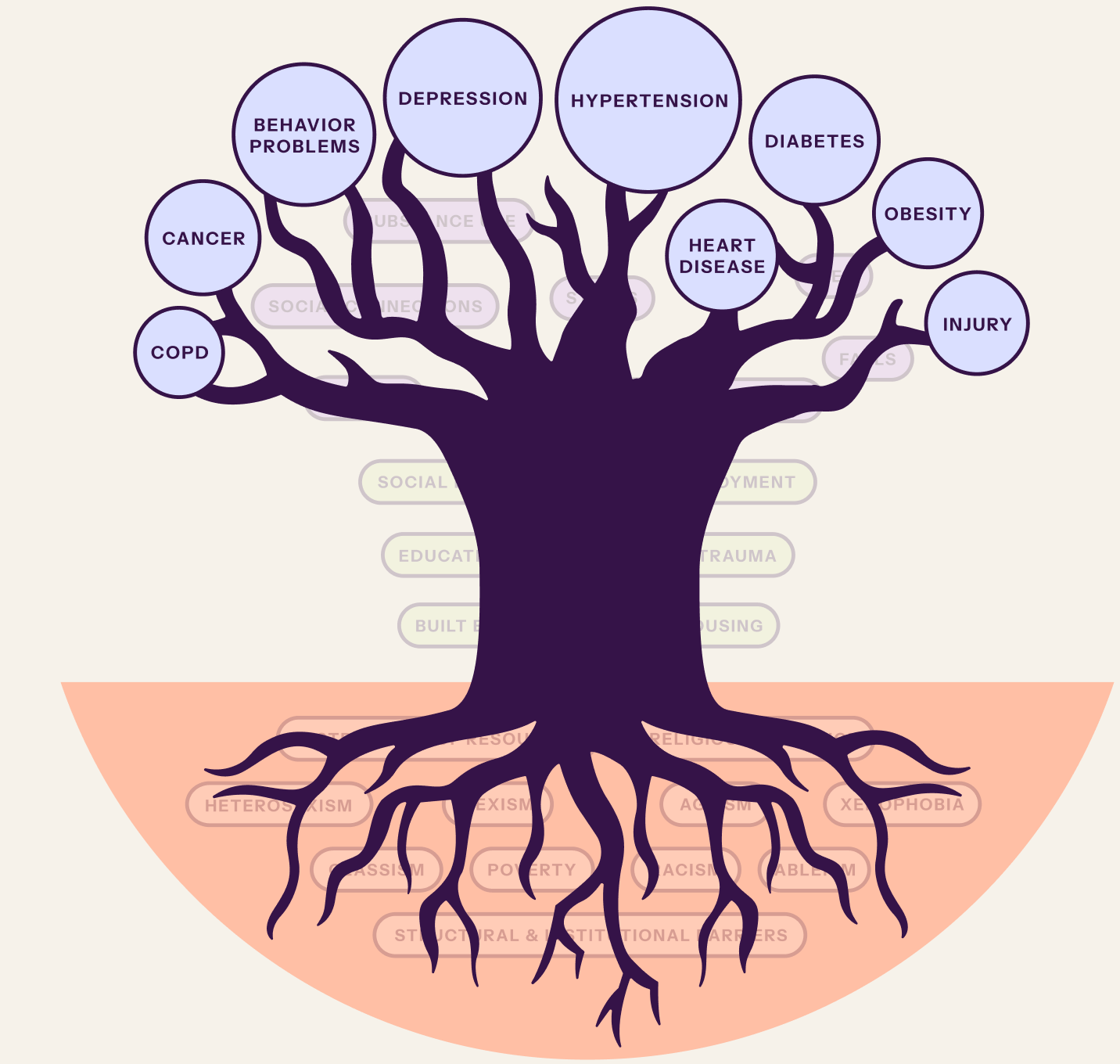
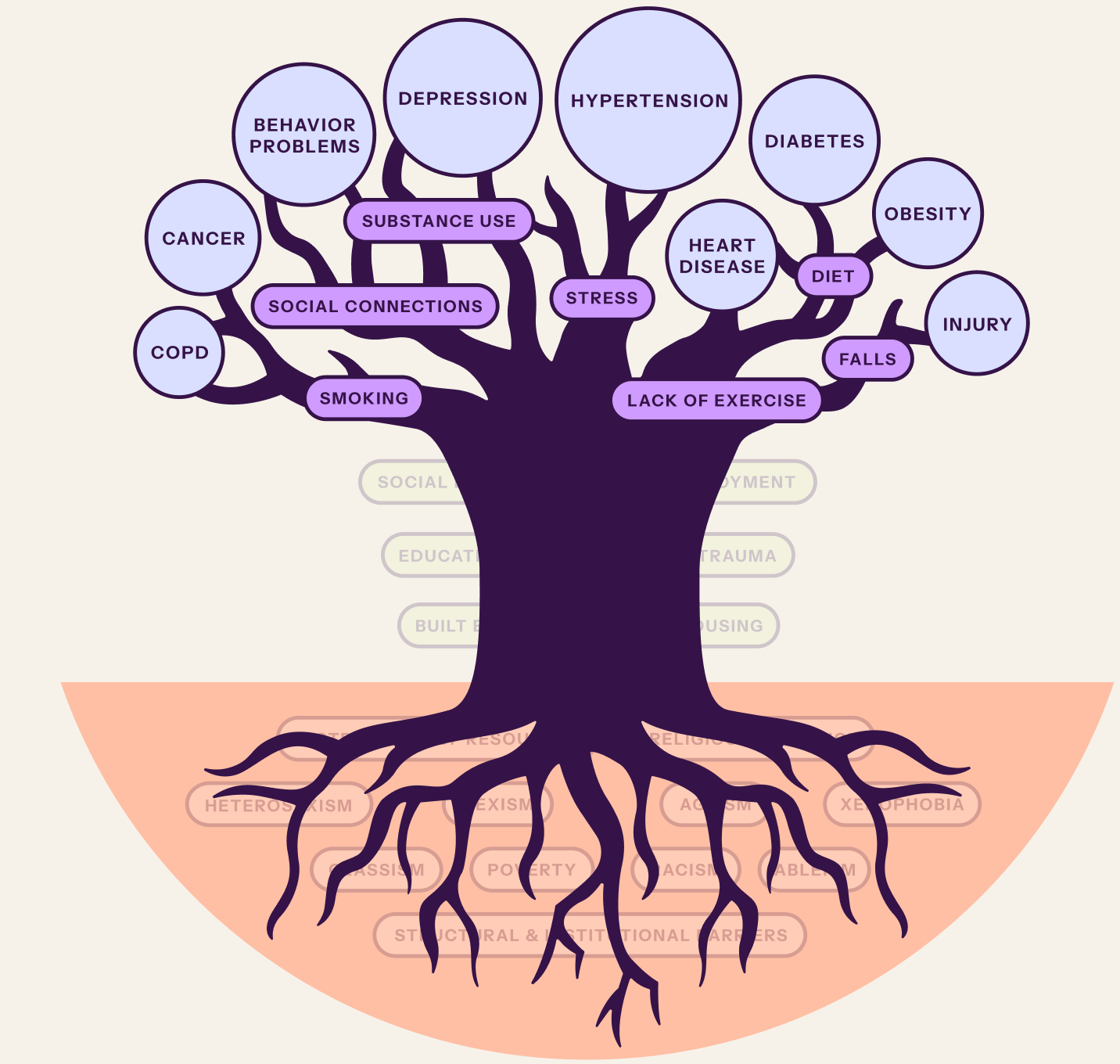
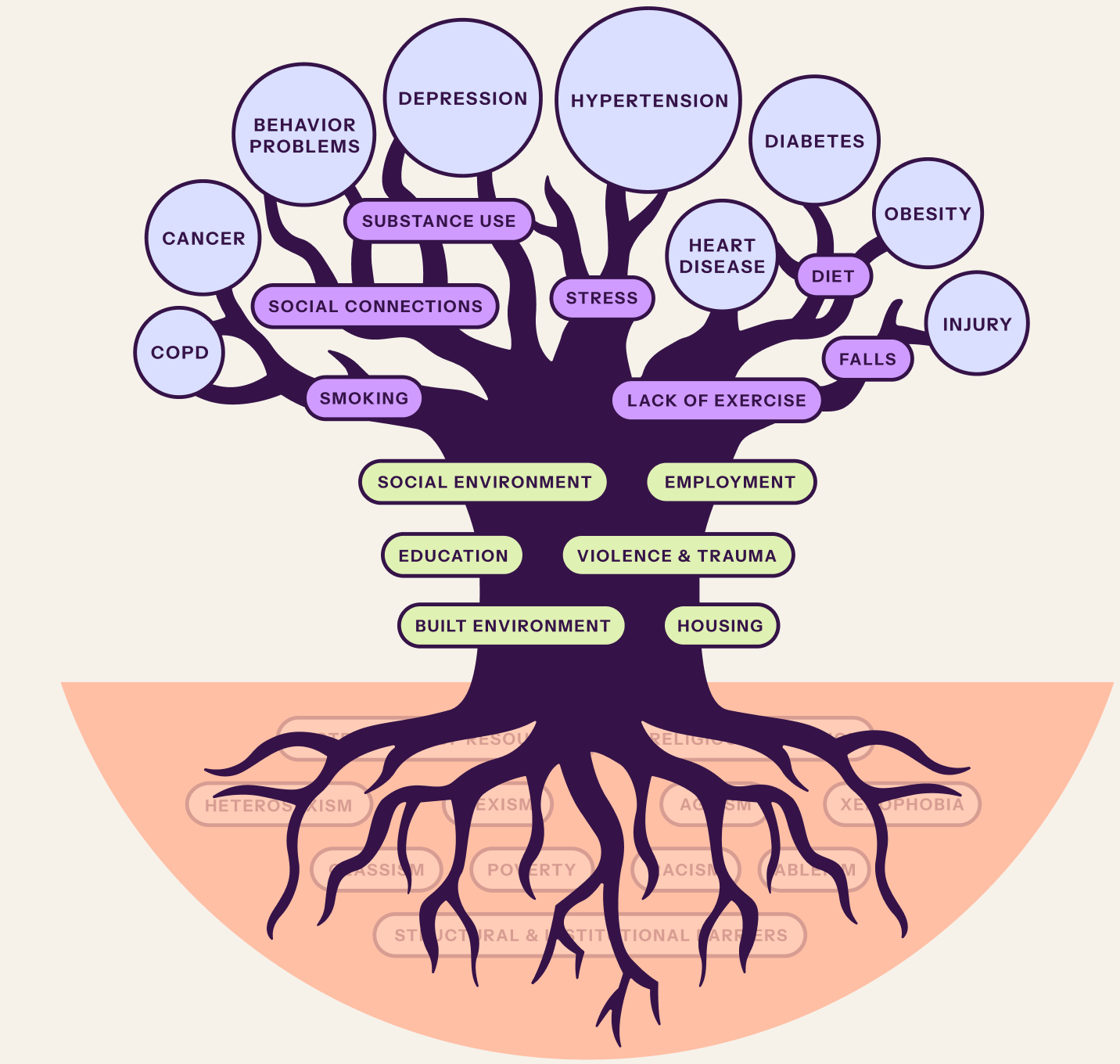
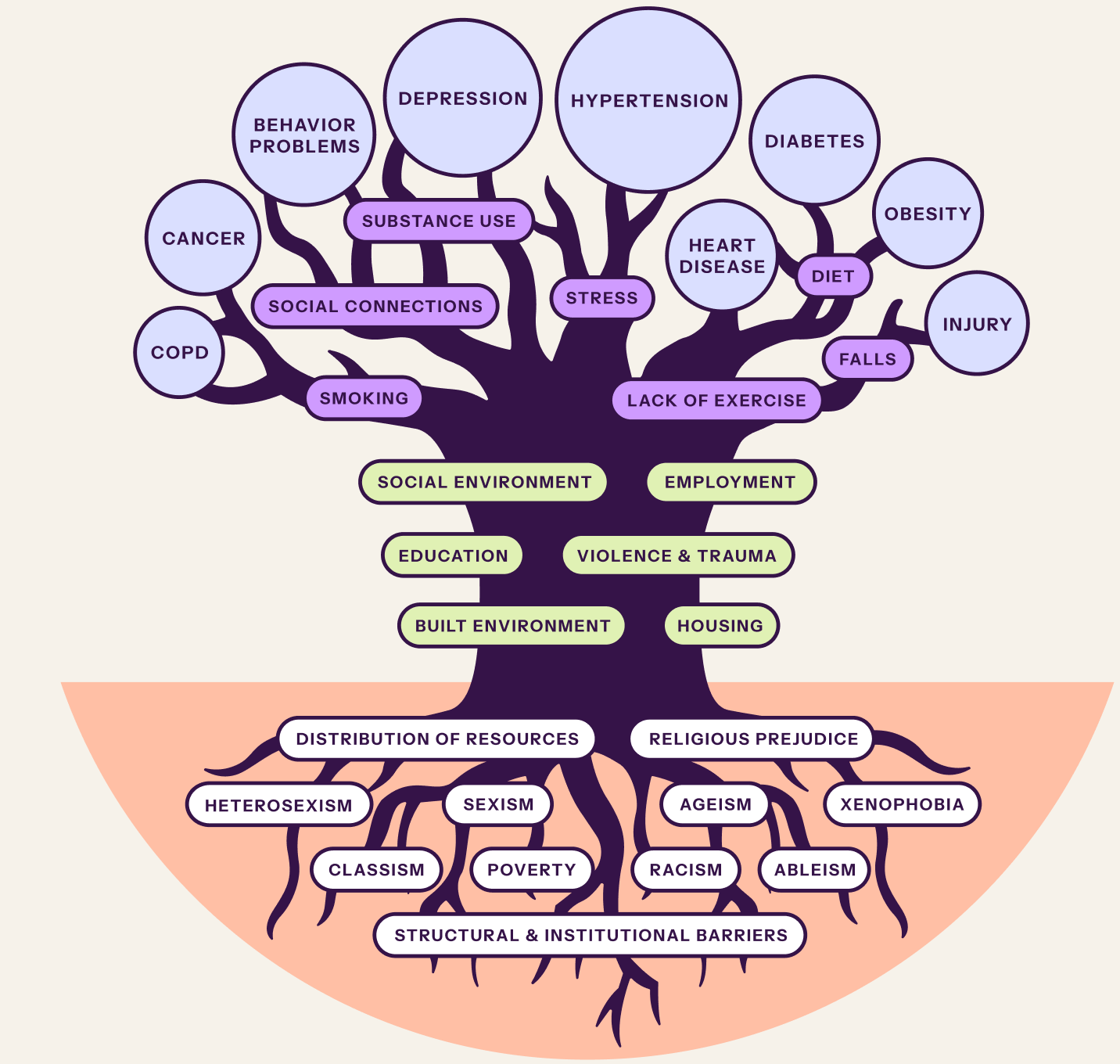
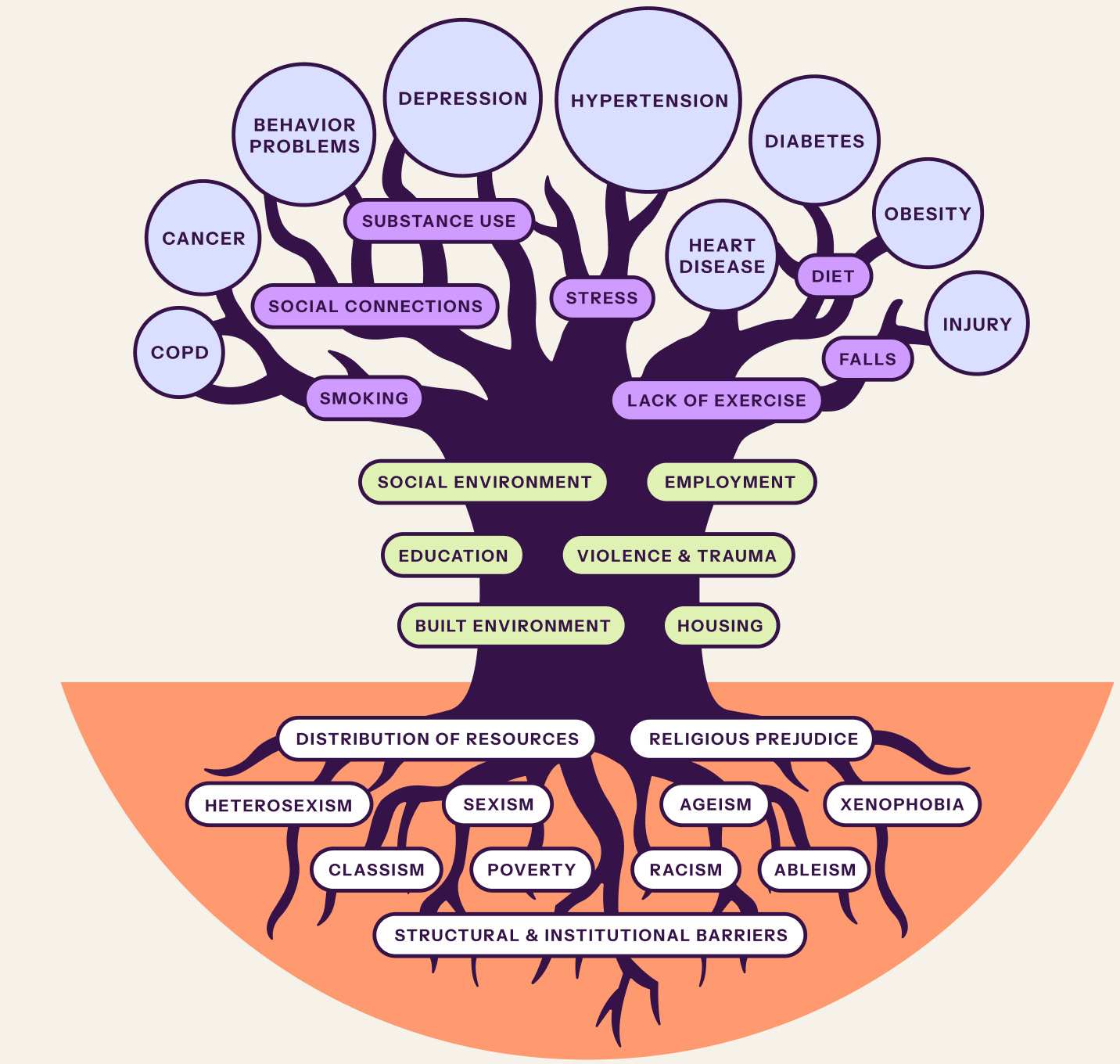
Dominant Culture & Narratives Soil & Groundwater
Building on the context above, we offer this guidance on how to use the tree in your own discussions.
- Begin with the leaves. When using the tree to discuss the overarching idea of health outcomes being a product of social determinants of health and root causes OR when using the tree to explore a specific health outcome affecting a community and potential solutions, work backwards, starting with the leaves and moving down the tree to the roots.
- Be open-minded. A key element of effective brainstorming is saying yes. When exploring the many different factors that contribute to health outcomes, be willing to consider the range of potential factors related to the problem you are discussing. Then, narrow down as needed to achieve the goal of your exercise, whether it be finding your niche to create a solution, identifying an area to advocate for policy change, etc.
- Imagine. Visualize what a healthy tree might look like for your particular situation. Put them side by side if it’s helpful for your group.
- Revisit. Return to the tree as needed to monitor progress on a particular issue, reconsider or build your understanding of a particular issue, or to contemplate alternative approaches.
You can download a blank version of the tree here.
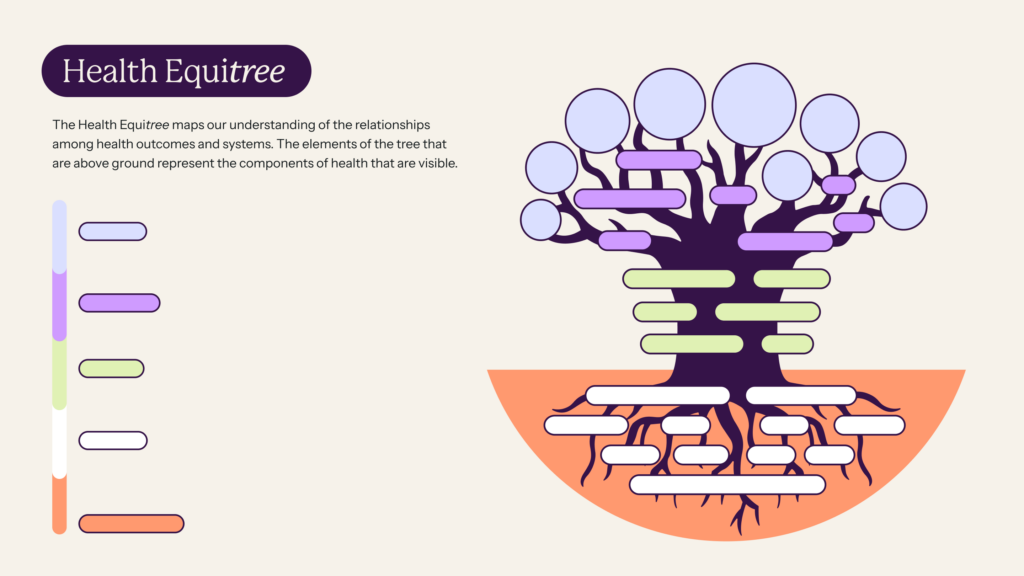
Let’s make impact together.
We co-create custom programs to meet our partners’ needs. If you’d like to explore what’s possible working with HRiA, we’d love to hear from you.
